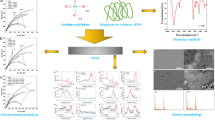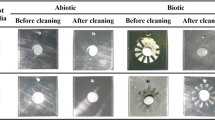Abstract
Corrosion of metals is a serious and challenging problem faced worldwide by industry. Purified Leuconostoc mesenteroides exopolysaccharide (EPS) coatings, cast from aqueous solution, inhibited the corrosion of low-carbon steel as determined by electrochemical impedance spectroscopy (EIS). There were two different corrosion behaviors exhibited when EPS films from different strains were cast onto the steel. One EPS coating reacted immediately with the steel substrate to form an iron (III) oxide layer (“rust”) during the drying process while another did not. The samples that did not flash corrode had higher corrosion inhibition and formed an iron (II) passivation layer during EIS testing that persisted after the cells were disassembled. Corrosion inhibition was strain-specific as polysaccharides with similar structure did not have the same corrosion potential.




Similar content being viewed by others
References
Barone JR, Medynets M (2007) Thermally processed levan polymers. Carbohydr Polym 69:554–561
Beech IB, Gaylarde CC (1991) Microbial polysaccharides and corrosion. Int Biodeterior 27:95–107
Beech IB, Sunner J (2004) Biocorrosion: towards understanding interactions between biofilms and metals. Curr Opin Biotechnol 15:181–186
Bennett LH, Kruger J, Parker RL, Passaglia E, Reimann C, Ruff AW, Yakowitz H, Berman EB (1996) Economic effects of metallic corrosion in the United States (1978). National Bureau of Standards (National Institute of Standards and Technology), Washington, DC
Chongdar S, Gunasekaran G, Kumar P (2005) Corrosion inhibition of mild steel by aerobic biofilm. Electrochim Acta 50:4655–4665
Cote G (2002) Alternan. In: Vandamme EJ, De Baets S, Steinbuchel A (eds) Biopolymers. Polysaccharides I: polysaccharides from prokaryotes. Wiley-VCH Weinheim, Weinheim, Germany, pp 323–350
Cote GL, Robyt JF (1982) Isolation and partial characterization of an extracellular glucansucrase from Leuconostoc mesenteroides NRRL B-1355 that synthesizes an alternating (1 → 6), (1 → 3)-[alpha]-glucan. Carbohydr Res 101:57–74
Fang HHP, Xu LC, Chan KY (2002) Effects of toxic metals and chemicals on biofilm and biocorrosion. Water Res 36:4709–4716
Jansson PE, Kenne L, Lindberg B (1975) Structure of the extracellular polysaccharide from Xanthomonas campestris. Carbohydr Res 45:275–282
Jayaraman A, Earthman JC, Wood TK (1997) Corrosion inhibition of aerobic biofilms on SAE1018 steel. Appl Microbiol Biotechnol 47:62–68
Jeanes A, Wilham CA, Miers JC (1948) Preparation and characterization of dextran from Leuconostoc mesenteroides. J Biol Chem 176:603–615
Jeanes A, Haynes WC, Wilham CA, Rankin JC, Melvin EH, Austin MJ, Cluskey JE, Fisher BE, Tsuchiya HM, Rist CE (1954) Characterization and classification of dextrans from 96 strains of bacteria. J Am Chem Soc 76:5041–5052
Kalendova A (2002) Methods for testing and evaluating the flash corrosion. Prog Org Coat 44:201–209
Leathers T (2002a) Dextran. In: Vandamme EJ, De Baets S, Steinbuchel A (eds) Biopolymers. Polysaccharides I: polysaccharides from prokaryotes. Wiley-VCH, Weinheim, pp 299–321
Leathers T (2002b) Pullulan. In: Vandamme EJ, DeBaets S, Steinbuchel A (eds) Biopolymers. Polysaccharides II: polysaccharides from eukaryotes. Wiley-VCH, Weinheim, pp 1–35
Leathers T, Cote GL (2008) Biofilm formation by exopolysaccharide mutants of Leuconostoc mesenteroides strain NRRL B-1355. Appl Microbiol Biotechnol 78:1025–1031
Majumdar I, D’Souza F, Bhosle NB (1999) Microbial exopolysaccharides: effect on corrosion and partial chemical characterization. J Indian Inst Sci 79:539–550
Penninga N, Kralj S, Euverink G-J, van der Maarel M, van Geel-Schutten I, Dijkhuizen L (2002) GTF180: a glycosyltransferase producing a glucan with anti-corrosive properties. Proceedings of the Nederlandse Vereniging voor Medische Microbiologie, p 22
Rhee SK, Song KB, Kim CH, Park BS, Jang EK, Jang KH (2002) Levan. In: Vandamme EJ, De Baets S, Steinbuchel A (eds) Biopolymers. Polysaccharides I: polysaccharides from prokaryotes. Wiley-VCH, Weinheim, pp 351–377
Seymour FR, Slodki ME, Plattner RD, Stodola RM (1976) Methylation and acetolysis of extracellular d-mannans from yeast. Carbohydr Res 48:225–237
Seymour FK, Knapp RD, Chen ECM, Bishop SH, Jeanes A (1979) Structural analysis of leuconostoc dextrans containing 3-O-α-glucosylated-α-glucosyl residues in both linear-chain and branch-point positions, or only in branch-point positions, by methylation and by 13C-NMR. spectroscopy. Carbohydr Res 74:41–62
Stadler R, Fuerbeth W, Harneit K, Grooters M, Woellbrink M, Sand W (2008) First evaluation of the applicability of microbial extracellular polymeric substances for corrosion protection of metal substrates. Electrochim Acta 54:91–99
van Leeuwen S, Kralj S, van Geel-Schutten I, Gerwig GJ, Dijkhuizen L, Kamerling JP (2008) Structural analysis of the a-d-glucan (EPS180) produced by the Lactobacillus reuteri strain 180 glucansucrase GTF180 enzyme. Carbohydr Res 343:1237–1250
Wilham CA, Alexander BH, Jeanes A (1955) Heterogeneity in dextran preparations. Arch Biochem Biophys 59:61–75
Acknowledgements
The authors thank Dr. Morey Slodki for the gift of the phosphomannan, and Ms. Joan Combie for the sample of Levan. The authors would like to thank Mr. Rick Haig for his technical contribution.
Author information
Authors and Affiliations
Corresponding author
Additional information
Disclaimer: Names are necessary to report factually on available data. However, the United States Department of Agriculture neither guarantees nor warrants the standard of the product, and the use of the name by the USDA implies no approval to the exclusion of others that may also be suitable.
Rights and permissions
About this article
Cite this article
Finkenstadt, V.L., Côté, G.L. & Willett, J.L. Corrosion protection of low-carbon steel using exopolysaccharide coatings from Leuconostoc mesenteroides . Biotechnol Lett 33, 1093–1100 (2011). https://doi.org/10.1007/s10529-011-0539-2
Received:
Accepted:
Published:
Issue Date:
DOI: https://doi.org/10.1007/s10529-011-0539-2




